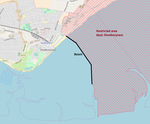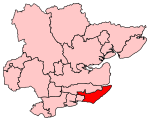Shoeburyness Depot
England rail transport stubsRailway depots in EnglandTransport in Southend-on-SeaUse British English from December 2016

Shoeburyness Carriage Servicing Depot is an Electric Traction Depot located in Shoeburyness, Essex, England. The depot is situated on the London, Tilbury and Southend line and is near Shoeburyness station. To the east of the depot is MoD Shoeburyness and there is a rail connection into that site from the depot.
Excerpt from the Wikipedia article Shoeburyness Depot (License: CC BY-SA 3.0, Authors, Images).Shoeburyness Depot
Southend-on-Sea
Geographical coordinates (GPS) Address Nearby Places Show on map
Geographical coordinates (GPS)
| Latitude | Longitude |
|---|---|
| N 51.5315 ° | E 0.7927 ° |
Address
SS3 9EL Southend-on-Sea, North Shoebury
England, United Kingdom
Open on Google Maps








